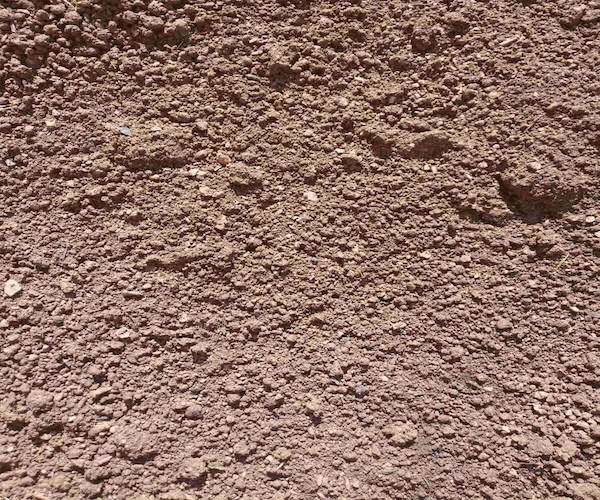Topsoil has a wide range of uses and capabilities, such as levelling lawns, laying new turf or even growing vegetables at an allotment. Some gardeners and landscapers make the assumption that the soil in their area is the same as elsewhere in the UK, but that’s where that assumption would be incorrect.
Some areas in the south of the UK can experience topsoil that is chalky, whereas towns in the north could experience soil that is sandy. In this guide, we outline the 6 different types of topsoil, what they’re useful for and where you might find it.
Contents
What are the 6 different types of topsoil?
With different varieties of topsoil available for gardeners and landscapers, you need to be sure that the topsoil you use is the correct type for the job you’re undertaking.
The 6 types of soil are:
- Chalky
- Clay
- Peaty
- Loamy
- Sandy
- Silty
Chalky soil
Chalk-based soil is renowned for being tricky to work with. The challenges of having this soil type can be quite overwhelming for a gardener trying to grow the ideal lawn or growing vegetables.
Rocky soils like chalk have large amounts of space beneath the surface and are prone to drying out and losing water and nutrients in large quantities, therefore those who have this type of soil in their garden must be prepared to water and fertilize more frequently due to this characteristic. This soil can be commonly found near chalk cliffs on the coast of the UK.
Good for:
- Rocky nature of soil resists compaction
- The soil warms up quicker in the summer
- Growing alkaline loving plants
Clay soil
To be classified as clay soil, it needs to be made of over 25% clay, meaning it’s heavy and often difficult to work with. Clay-based soil is made up of very small particles with spaces between them which means the soil holds a high amount of water, drains slowly and takes longer to warm up in the spring and summer.
With its high-density nature, the winter months can be quite tough for gardeners and landscapers as it is prone to waterlogging and disrupting the growth of your garden turf. This soil can be commonly found along floodplains of rivers and streams or on the bottoms of ponds and lakes.
Good for:
- Providing essential compounds and minerals to crops
- Holding large volumes of water
Peat soil
As per the International Peatland Society, peat soil is defined as “the surface organic layer of a soil that consists of partially decomposed organic matter, derived mostly from plant material, which has accumulated under conditions of waterlogging, oxygen deficiency, high acidity and nutrient deficiency.”
Normally dark brown or black in colour, peat soil is soft, easily compressed due to its high water content, and rich in organic matter. This type of soil can be commonly found in peatlands and is frequently found in general-purpose topsoil.
Good for:
- Root structure and ability to hold water
- Providing essential compounds and minerals to crops
- Improving soil aeration

Loam soil
Loam soil is widely regarded as one of the healthiest soil to grow plants in. It has a rich, dark brown appearance that feels moist and can often be clumped into a crumbly ball. The mixture often consists of 20% clay, 40% silt and 40% sand, meaning it somewhat eliminates the negative issues of each individual soil.
Although this type of soil is best for general gardening purposes, it can be prone to erosion and if the balance of the soil is not quite right, it can lead to negative side effects. This soil doesn’t tend to occur in natural circumstances.
Good for:
- Holding moisture and nutrients
- Providing a superior habitat for microorganisms
- Allowing water and air to move freely
Sand soil
Sandy soils are dry and gritty to the touch and if you tried to roll slightly wet sandy soil in your palms, it would crumble through your fingers easily – this is because the particles in sandy soils have huge spaces between them.
Due to its particles being far apart, sand-based soils are prone to losing a lot of water and nutrients. This can be good in the winter for things like sport pitches and golf courses but would suffer in the warmer months. This type of soil is commonly found further beneath the ground than other topsoils.
Good for:
- Ground drainage
- Cultivating a large area of ground
- Providing space for root growth
Silt soil
Silt soils are similar to sandy soils when they’re dry, except that their particle sizes are much smaller resulting in a feel that is soft to the touch – when you roll silt-based soil between your fingers, dirt is left on your skin with a smooth texture, kind of like flour.
This type of topsoil is best for general purpose gardening such as levelling lawns and growing plants and vegetables. This type of soil isn’t commonly found in the UK and is often bought in bulk bags.
Good for:
- Holding water and nutrients
- Moving and working with
- Variety of general gardening uses
Where can I purchase topsoil and turf from?
Alsoils+ have been servicing domestic and trade customers for over 35 years with the highest quality topsoil, leaving you safe in the knowledge that we can cater for your needs. We supply topsoil that is suitable for: vegetables and fruit, turf and lawn, multi-purpose uses and projects that require premium topsoil, so you can be sure your garden is given the love it deserves.





